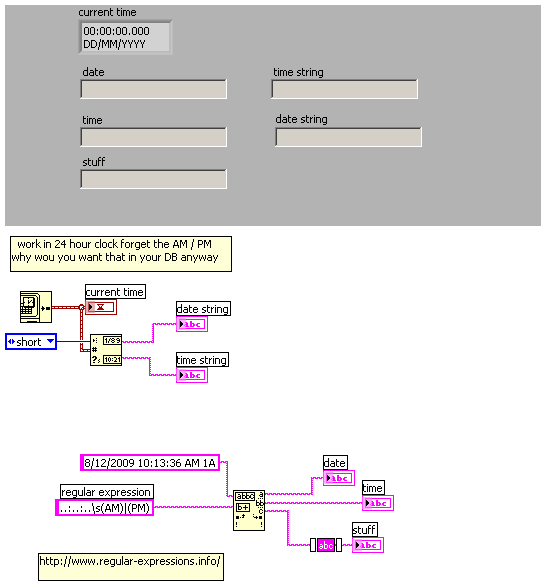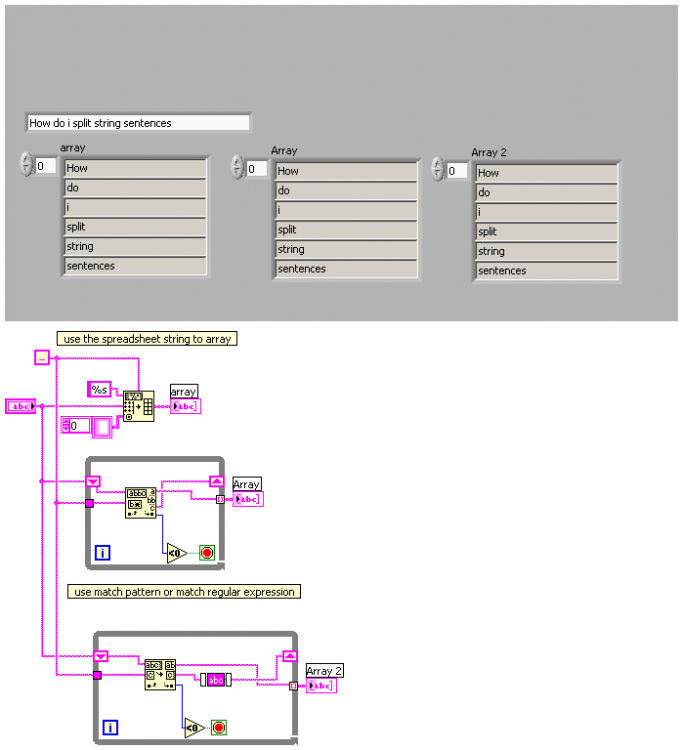-
Posts
416 -
Joined
-
Last visited
-
Days Won
12
Content Type
Profiles
Forums
Downloads
Gallery
Posts posted by dannyt
-
-

ah the afternoon shift has now arrived :-)
-
This appealed to me, nice seeing all the people NOT taking the escalator
linky (not sure If I can the the embedding working
-
 1
1
-
-
Congratulations Jim
 :thumbup1:
:thumbup1:Dannyt
-
With VI Tester, writing unit tests is fun,
Jim,
I sometimes wonder if you should get out a little more

Just to tie in a previous thread covering this topic.
-
Hey great this now works OK for me as expected.
It looks like the Bug fix yesterday on LAVA changed this.
I am happy if you want to close this off now as fixed :-)
many thanks
Danny
-
Hi!
in LAVA Lounge
Hi
Welcome to LAVA
-
[speaking purely as a developer myself, not speaking in any way for NI for this post.]
Is a personal copy of LV cheap? Heck no. But neither is a personal copy of a lot of cool software. I'd like to say, "use LV for everything it is appropriate for." But I'd also like to get a paycheck every couple weeks, which means LV costs money, which means "use LV if you can afford to use it in all the times where it is appropriate". It'd be nice if it were down around $250, like Visual Studio, but we don't have anywhere near the volume that MS does to be able to make back our expenses at that low a price.
I do totally understand where Aristos is coming from with this comment, that NI need to make money to pay for their developers etc.
But as my LabVIEW experience grows and I do more and more LabVIEW both at work and occasionally at home, I do feel I am doing the wrong thing because as an individual developer or "home enthusiast" programmer the cost of LabVIEW is out of reach. So the more LabVIEW is do, the more time I spend on it leave me more exposed I sometimes feel I become.
Dannyt
-
Hi,
I noticed on the View active topics page are the bottom their is an option
Active in the last ...... option with options of <24hours> <week> <2 weeks> etc.
But only the 24 hours selection works. If you select <week> and hit GO .... it looks like it correctly finds all the results as it come up with 3 pages of results showing page 1, but if you try to go to page 2 or 3 it sets itself back to 24 hours so they can never be seen, I see this in IE6 and Firefox 3.5.3
-
At work we are using TFS and follow the branch, modify, merge pattern for code development. This can cause all sorts of problems when code collisions occur in classes or project libraries, such as what might happen when multiple developers change the class .ctl or library VIs are added or removed. What process steps do you go through when resolving conflicts like this to avoid broken projects?
Hi we use the same branch - modify - merge pattern, we only have six developers here and the only advice I can give really is communication between the developers.
That said some guide that help us (and only help they do not solve the problem) are :
- we do have a simple web tool so at a button click anybody can see what files other people have out on branches (very useful)
- Plus we try
 and keep the work / architecture spilt but it never really works.
and keep the work / architecture spilt but it never really works. - merge often / merge often. This is key and also relates to branches on text code. Keep branches as simple as possible and merge as often as possible. I strongly agree with this
- if one of use is doing a change that will result in lots of recompiles we plan that change in with everyone else.
This is the one MAJOR problem I have with LabVIEW and to me it is a major problem. It is bad enought with six developers I cannot even imagine what it would be like with 50 + developers and yet this pattern works fine with 100+ developers with text languages...ah well not point in wishing it will go away.
Dannyt
-
 1
1
-
Hi,
We have been doing code reviews QCP's (quality Peer Reviews) for a long time now on all our "new" software and "software changes".
Our process is based on one we use site-wide for C++, C (30 + develpers) and LabVIEW (6 developers). I have uses this same basic process for many years at different compaines
It is done as a formal traceable process, built into our own web based tools that we use to control ClearCase our source control tool.
The web based tool we created and use acts as a both records keeping system, who was the reviewer, log of review comments (and developer responses) and process machine, controlling when a QCP (quality Peer Review) needs to be done.
- When do we do a QCP
Note a branch could have one file on it or lots. Typically a branch is kept small in scope, even for new major new software we would try to built it up a bit at a time with a different branch for each bit. This is partly to make the peer review of a branch more manageable. In LabVIEW we only really get big branches when we have major recompile issues.
A branch status goes : development - ready for QCP -- passed QCP (or back to development)- QCP levels
OK we all live in the real world and not all software changes are equal, plus sometimes pragmatic decisions are needed, "FIX THIS NOW" so we have some different level of QCP that are carried out. Our QCP levels are
None - very rarely used level , must be accompanied by a good reason for this type of review, maybe a save due to recompile only
Maint - just a quick check over the changes made.
High - examine the changes made and their context.
Detail - same as above really possible we do not need this option
Demo - show the review the change in action
The key here is that, the information is recorded (so traceability) the developer has to think about it. I would say that 99.9% of reviews are done as high /detail
- What happens in a review
First off, during a review it is the developers responsibility to satisfy the reviewers comments or questions, after all it it the review that passes or fails a QCP. If a QCP passes then the code is merge into the mainline and the branch is closed. If a review fails the branch goes back to a development state and the developer needs to address all the reviewers comments.
A reviewer will do the following for all reviews except the None type.
1) Load all the top relevant top level VI's and ensure that a) there are no broken run arrows b) they close with no save's needed.
2) Run the VI analyser on all the files on the branch. We have this automated and the analyser config spec set to our custom requirements. All failures will be visually examined.
We have a document which deals with the analyser results, which must be fixed / which should be fixed (or explained away) which we can ignore and in what circumstances.
We use the VI analyser as a style guide tool.
3) The reviewer will use the OpenG compare to disk tool (modified to work with LabVIEW 8.2) to visually look at the code changes between the current version on main and the ones on the branch under review.
For a high / detail review (our normal review type is high) the review will also look at the wider context of the changes and how they fit into the general scheme of things, how they meet the requirements of the change or bug fix.
Any comments the reviewer makes are logged.
If the reviewer is not happy with the code the branch is set back to development status, the comments are mail to the developer who must then, explain / justify a code change or modify the code. Being a smallish team, often the reviewer and developer will sit together during a review so typically when a review has failed the reviewer and developer have already agreed on what corrective action is required to pass next time, but the comments and reply's are always recorded.
Following a failed peer review, the developer does their changes and any retests again (weell the code has changed) and then resumits the changes back to the original reviewer for a new QCP, hopeful it will pass this time :-)- Other comments
I would like to get some automated unit testing built into this system but it is a while before that will happen.
Having done QCP's for many years, I can honestly say Iwould not develop software in ANY language without a peer review process of some sort.
The value of getting somebody else to view your code cannot be over stated. Just from a simple style point of view if nothing else. When you KNOW somebody else is going to look at your code with a critical eye you tend to write your code differently.
Nearly every code review results in a valid comment that will improve the code, this is NOT to say the the original developers was poor or lazy, just a different view is taken by the reviewer, in some case our peer review has stopped code going into our mainline that would have been a major problem if it had got released.
Finally, I did see a really good NI webcast Performing Technical Code Reviews to Improve LabVIEW Code Quality but though I found a link to it at the bottom of the page it seems to now be removed
I hope this makes some sense and is of some use
cheers
Dannyt
-
 2
2
-
Pun
in LAVA Lounge
Oh, NOW I get it...

I also had to be spoon fed the answer to this one.... duh I feel pretty lame now

-
Hej Danyt
If your example has to work you must change the Regular exspresion from this "..:..:..\s(AM)|(PM)" to this "..:..:..\s(AM)|..:..:..\s(PM)" .
regards Bjarne
quite right well noticed :-) or you could use ..:..:..\s(A|P)M
well I did say to "play around a bit"
dannyt
-
 1
1
-
-
Hi. Thanks alot. that was what i needed. However, if my string comes in the following format (8/12/2009 10:13:36 AM 1A), the AM would be separated from my time. The AM is crucial as I am required to insert it into my database together with the time. This is the reason why i would like to split the string. Also, can you tell me how i can retrieve each word from the array as I will need to update the values into my database. Many Thanks.
Morning again.
Couple of things first. I strongly suggest you read a little about regular expression and how to use them, then have a play with them. They are very powerful for this type of thing involving a predictable pattern and splitting it up. Try Regular expressions and look at the LabVIEW help for the "match regular expression's".
I would also suggest you would be better working with a 24 hour clock system rather than AM and PM, from past experience I think using AM and PM will lead you to nothing but woe; when you come to get data out of the database and analyse the results things can get messy. Also where are you getting your time from if you are using LabVIEW its self then you would be better using the LabVIEW timestamp type.
Anyway some example below that might help you
cheers
Dannyt
-
 1
1
-
-
Congratulations!
Jolly well done.

-
Hi,
It all depends on what you want to actually do with the split parts afterwards, there are several ways to skin this cat, typically you use the match pattern, match regular pattern , split string function in a while loop until you find no more matches. you can also do it all at once using the spreadsheet string to array.
-
 1
1
-
-
Doesn't the 'View Unread Content' link in the upper right corner (next to the RSS icon) do what you want? Assuming, of course, that you previously marked the threads as read.
Many thanks Daklu, that is exactly what I want sorry for wasting people time I had missed it up by the RSS feed.
-
Hi Guys,
I was away from a PC for the last part of last week (a great time at the Bristol Balloon festival). and with NI week going on I wanted to go over last weeks posts.
I really like the short-cut to Today's active posts on the portal page. But in Lava 1.0 I remember there was an easy way just to roll back over all posts in time so it was relativity painless to see all the post during the last week. To do this now it seems I have to go through all the forums one by one and go back pages in each.
I do not know if this would be possible / easy to implement or if anyone else would find it useful
cheers anyway
Dannyt
-
gentle bump.

I just wanted to know if you thought this was working as you yourself expected ?
-
Thanks for the replys, I will have to give it a little more thought.
Danny
-
Hi AQ,
I do not mean to take this thread of topic but your comment "You can kill an app's performance by needlessly using references of any kind" made me stop and worry exactly what you meant and in what context
 .
.I have started to rewrite some very old systems here using a mixture of the JKI State Machine and a parallel user event loop. Until now I was feeling quite pleased with myself, I felt it look good code, was following a good pattern, however now I am not so sure.
On my top-level front panel I have quite a few controls and indicator a number of which need updating from lower in the code (as we all often do).
A lot of my style to tidy things up was to cluster common control / indicators together, I would then create references to these clusters and other controls / indicators on the front panel. All these references would then themselves be clustered together and, in the JKI state machine world these clusters of references would then going to shirft registar so they could be accessed everywhere by just pulling them out of the cluster as and where required.
Your comments abvoew make me thing this may be a very bad way of doing things.
Could you please expand this maybe in a new thread
cheers
Dannyt
-
I am beyond words

It time for me to lay down me mouse and crawl away from LabVIEW my little head hurts now

Still I see a new edition of peter Blume's LabVIEW Style Book will be needed
Dannyt
-
It's a wonderful wonderful place to be
 As an aside, anyone hear about the new "Alice in Wonderland" movie coming out? Depp and Burton - here we go again...
As an aside, anyone hear about the new "Alice in Wonderland" movie coming out? Depp and Burton - here we go again...Well just to stay of topic, a lot of that was filmed last year down in Cornwall and Devon, a friend of mine who is a school teacher took one months unpaid time of to be an extra in the film.
She said it was a very interesting but bizarre experience.
-
Hi Admins,
Sorry to go on about this, but I am not yet clear about it.
Do you consider the search function as it exists to be functioning correctly as expected in terms of the + (AND) option or if this a bug ?
cheers
Dannyt
-
Yep, I've been developing an application based on what Mr. Blum calls in his LabVIEW Style Book the "Modular Multiple-loop Application Framework" (page 283>285), each loop being based JKI SM.
Opening book to those pages and reading now, thanks. Does mean skipping forward as I am only really on page 98 so far

cheers
Dannyt





Excellent intro presentation on Object Oriented Programming in LabVIEW
in Object-Oriented Programming
Posted
First thanks for this I found it very interesting, I do really need to spend some time looking more at LabVIEW OO and start doing some....
.... however .....
please please please , why can NI not make this type of thing in a downloadable form, am I being silly is this not possible with webcast ?
, why can NI not make this type of thing in a downloadable form, am I being silly is this not possible with webcast ?
This is not the first and I am sure not the last really good webcast / video presentation I have come across on the NI site, that I have though wow what a great and useful presentation and I really want the opportunity to view them several times and at time when I have a bit more peace and quite. Also I have on several occasions tried to find a previous webcast /video on the NI site that I rememberer and find the links are not longer valid and I cannot find it.
dannyt